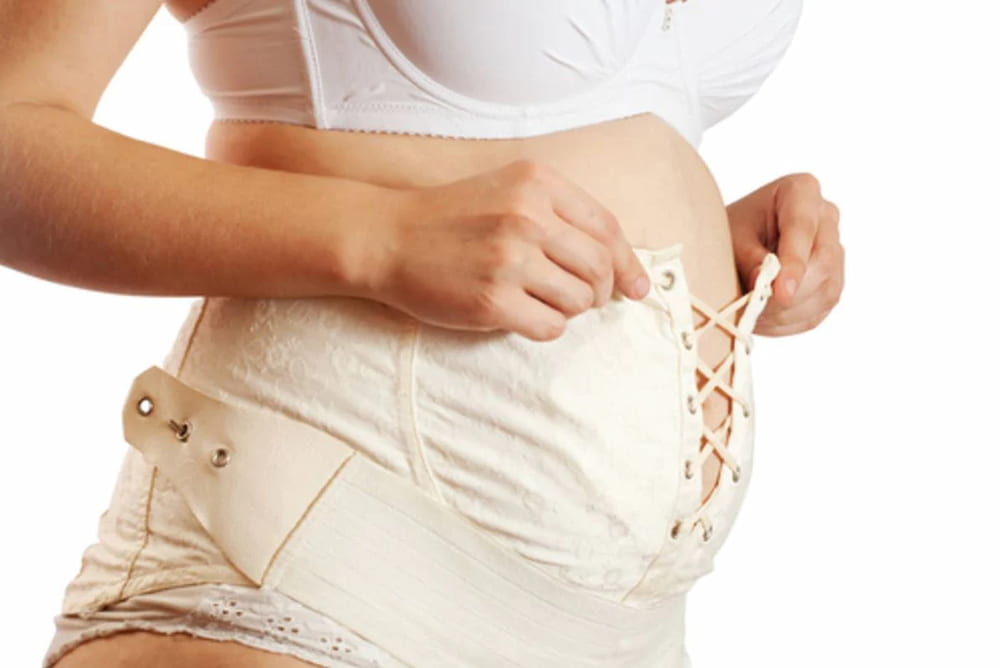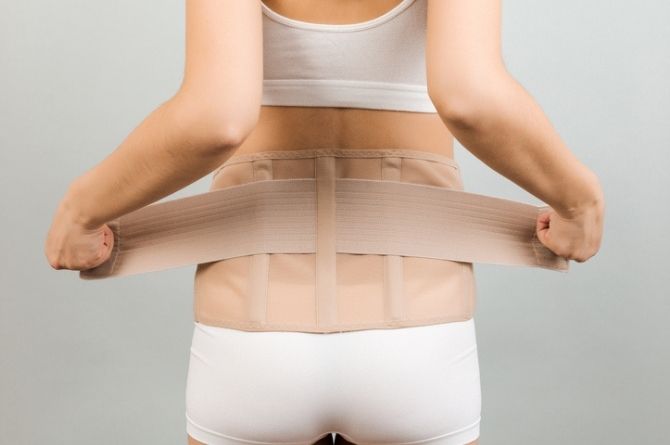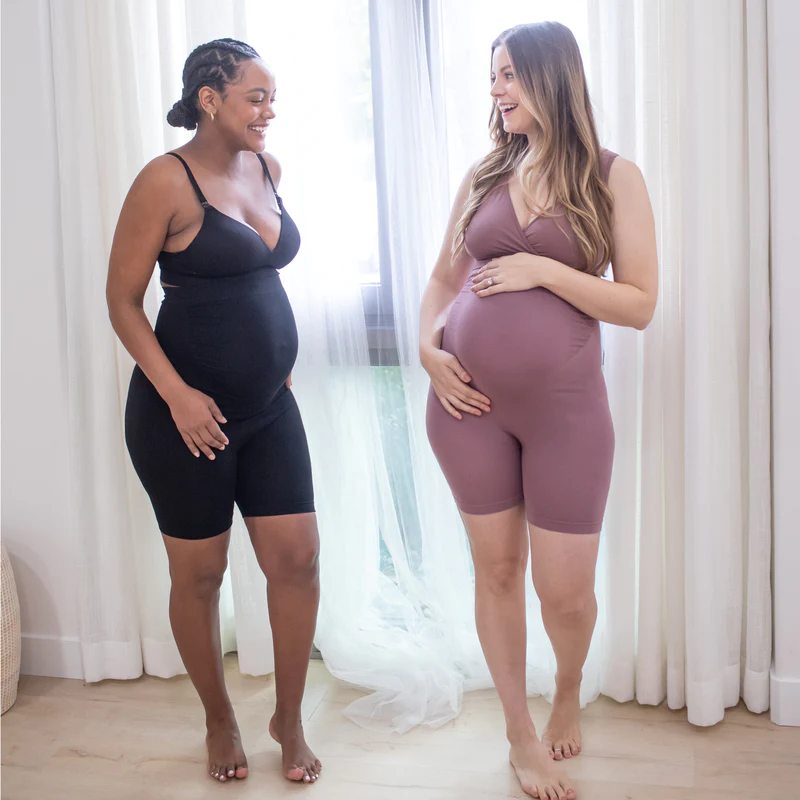Can You Wear A Waist Trainer While Pregnant? All You Want To Know

Despite being pregnant, you want to look stunning and flawless because you have to attend a significant event. A waist trainer may cross your mind as a dream remedy, so you can ponder that possibility.
But, Can You Wear A Waist Trainer While Pregnant? Is it okay to wear tight, restricting shapewear while carrying a child?
The type and size of the garment will determine this. If your waist trainer restricts movement and leaves no room for the baby, it could be uncomfortable and complicate delivery.
We’ll answer these questions in-depth below, along with advice on what to wear and what not to during pregnancy.
Keep reading.
Is It Safe To Wear A Waist Trainer While Pregnant?
Depending on the style and size you select, wearing a girdle during pregnancy may or may not be safe. However, it is not advised to use a waist trainer while expecting. Because waist trainers are too restrictive and exert too much pressure on several body parts, which may result in miscarriage and harm your health.
In addition to causing excruciating discomfort, constricting girdles can lead to heartburn, yeast infections, decreased blood circulation, and pain in various areas, mostly the abdominal area.
The warning signs that the staple is too tight are when wearing a girdle you feel uncomfortable, painful, or have trouble breathing.
Do’s
Pick A Larger Size
Many expectant mothers have seen positive effects from donning more accommodating, elastic, and loose staples, such as bone-free neoprene cinchers in large sizes and specially created maternity clothing.
Choose girdles with slightly larger sizes than usual, more support for the area of your lower abdomen that contains your baby, and little compression at the waist.
Stick to elastic materials only. Excellent choices include latex, Lycra, spandex, and neoprene.
If the undergarment is too snug, take it off or adjust it right away. Instead of shrinking your body, rocking shapewear should support it.
Go For Specialized Maternity Shapewear
Pregnancy-specific shapewear, which was created to meet the needs of pregnant women, is the best option if you’re unsure of which girdles to select during your pregnancy.
Those tube-shaped control underwear resemble belly bands more than anything. They serve two purposes and are worn around the expanding belly.
First, they protect unbuttoned or unzipped pants, extending the life of your pre-pregnancy dresses or pants. Second, as your body adjusts to the size changes, your belly and back will receive gentle support.
Alternatives include maternity over-the-bump shapewear leggings, which perform a similar function.
Don’ts
Choose High-compression Garments
Avoiding girdles with extremely high compression is advisable for comfort’s sake.
During this time, your body goes through a lot of growth and changes, which can be uncomfortable due to high compression and excessive stress.
You can visually eliminate any bump and appear sleeker without experiencing extreme discomfort with medium to light control.
Wear Corsets
It makes sense that fetal health specialists and medical professionals keep stressing that pregnant women shouldn’t wear too-tight clothing during this time. Even if the baby isn’t squeezed, wearing tight clothing will undoubtedly hurt and inconvenience them. Sadly, a corset fits into this category.
While carrying a baby, corsets may cause nausea or dizziness because they alter your regularity in using the restroom and digestion. In more severe cases, you may experience bloating, acid reflux, vomiting, shortness of breath, increased urination, and these other symptoms.
All these problems are not worth a thin, smooth so-called appearance. Keep in mind that your child’s wellbeing and life are of utmost importance.
Wear Waist Trainers
Waist trainers are typically inappropriate to wear while pregnant, though this isn’t always the case.’
Internal organs like your intestines, spleen, liver, abdominal muscles, and ribs shouldn’t be excessively squashed and compressed by maternity clothing; a waist trainer does almost all of these things.
If you tie it up too tightly, it may affect your posture, limit your ability to breathe and use your abdominal muscles, restrict your range of motion and cause rib fractures. Even though it might not harm your fetus, it might hurt you nonetheless! Therefore, it is best to stay away from these clothing during pregnancy.
However, if you want to wear a Spanx waist training girdle occasionally for a posh appearance at a high-end event and find that it doesn’t irritate your skin or body, you can.
And most importantly, keep in mind that the key is moderation, and always consult your doctor’s advice before putting on anything constricting

Corset, Waist Trainer, Regular Shapewear, Maternity Shapewear
Many individuals find it difficult to tell the difference between waist trainers, corsets, regular shapewear, and maternity shapewear; some may even believe they are the same.
They are distinct, in fact. While corsets are not considered shapewear, waist trainers might be.
Corsets
The purpose of a genuine corset is to narrow the shape of a woman’s bust, hips, and waist while gradually reducing size.
The stiffening strips of the best corsets are frequently made of plastic, metal, or wooden busks because the lace in the back of the garment needs to be stabilized and requires a high level of strength.
Although they are well known for being extremely uncomfortable, corsets are typically a staple to highlight femininity with such hard-busk materials.
These outfits are designed to alter your body by force; they squeeze your bust, hips, and waist into a small area.
Waist Trainers
Waist trainers work differently than this. Nowadays, neoprene or latex are the most commonly used flexible, supple materials in waist trainers. In the event that they have bones, they are also very flexible.
The idealized minute waist size didn’t stop getting smaller until corsets became unfashionable due to health issues and discomfort.
The majority of waist trainers available today are comfortable enough to be worn all day, including while working out, and to keep your body in the proper position.
Regular Shapewear
Regular shapewear is more of an umbrella term for any type of girdle worn by women to help minimize lumps and bumps.
No girl, thin or fit, wants to put on a bodysuit or a stunning dress and discover something unflattering, uneven, or not smooth about their body.
Regular shapewear was created to give women more self-assurance when wearing their favorite form-fitting clothing.
Maternity Shapewear
Regular shapewear and maternity shapewear differ in that the latter allows for more room for the belly.
Shapewear for expectant women (of which Spanx is the most well-known brand) typically uses the standard compression-shaping technology for the legs, bottom, and hips but also includes a wire panel that provides the abdomen with gentle support.
Given that it doesn’t press against or squeeze the baby, this garment is most appropriate for expectant mothers.
Additionally, maternity shapewear is ideal if you want to support your body while still feeling comfortable by gently compressing the belly.
In other words, these items were specifically designed with pregnant women’s bodies and comfort in mind.

How Long Can A Pregnant Woman Wear A Waist Trainer?
Your health and the health of your unborn child are just two of the many variables that will determine how long you can wear the best waist trainer without risk during pregnancy.
- Generally speaking, you should limit the amount of time you spend wearing a waist trainer.
- Additionally, it’s critical to check that your waist trainer is not too tight.
When wearing your waist trainer, you should stop right away if you feel any pain or discomfort.
Does Weight Loss Affect Future Pregnancy?
Nothing in the evidence suggests that belly training affects subsequent pregnancies.
The fact that every pregnancy is unique must be remembered, though.
It is best to discuss waist training with your doctor if you are worried about how it might affect your upcoming pregnancies.
FAQs
Aside from the pertinent queries, we make an effort to address some misperceptions about maternity clothing and girdles.
What Are The Signs That My Shapewear Is Too Tight?
Anyone who has worn too-tight shapewear for an hour or longer knows it will be difficult to breathe deeply or even eat a typical-sized meal.
Breathlessness, a decreased oxygen supply, lightheadedness, and dizziness are warning signs that a waist trainer is too tight or snug.
You shouldn’t need to exert much force to fit your body into the fabric, regardless of the style of girdle you choose. If so, it’s probably too small for you.
In addition, the garment shouldn’t show any bulges beneath clothing; otherwise, it might be too tight or too big and ineffective.
Can Using A Waist Trainer Result In Pregnancy Loss?
No, using a waist trainer won’t make you miscarry. You should see your doctor, though, as with any pregnancy.
I’m Pregnant, But Can I Use A Waist Trainer?
Yes, you are able to use a waist trainer during pregnancy. However, you should only wear it for a few hours at a time, check that it is not too tight, etc.
How Does The Womb Change When I Wear A Waist Trainer?
No, using a waist trainer has no impact on the womb.
Can A Pregnant Woman Wear A Corset Wedding Gown?
No evidence exists to support the idea that a pregnant woman cannot wear a corset wedding dress. But before doing anything, consult your doctor as you would with any pregnancy.
Maternity Shapewear Vs. Compression Clothing
What’s the difference between maternity shapewear and compression clothing? Yes and no.
The majority of maternity girdles will smooth your figure beneath that pretty dress, offer comfort, and stop thigh chafing and excessive sweating. Compression apparel, such as leggings and socks, provides health advantages throughout pregnancy.
Your doctor might recommend wearing compression socks or leggings if you plan to travel on vacation, especially if it involves a flight or a drive that lasts longer than 3–4 hours. You are susceptible to DVT (deep vein thrombosis), which happens when a blood clot forms in your lower legs and travels to your lungs.
Sitting for a long period of time may increase your risk of developing DVT. Leggings with compression or compression socks can prevent the development of these thromboses.
Always consult your midwife before leaving home to determine what is best for you.
Keep in mind that the clothing you are wearing probably isn’t the same as real compression leggings.
Final Words
In conclusion, it shouldn’t be too difficult to wear a waist trainer or shapewear while pregnant. If you know which products are appropriate for you and which ones are not, it may even have some positive effects on your physical appearance.
Understanding and listening to your body is crucial, as is giving it time to adjust to changes and putting safety and health first.
Many thanks for reading.